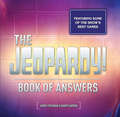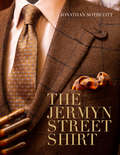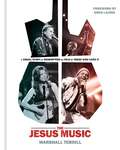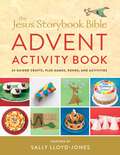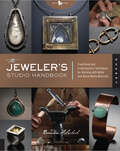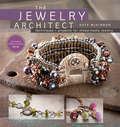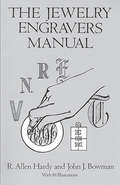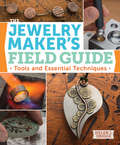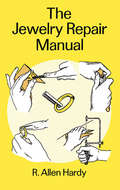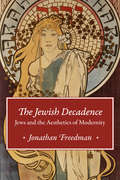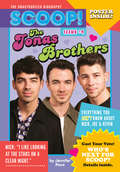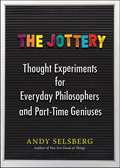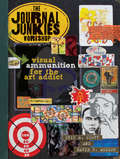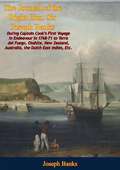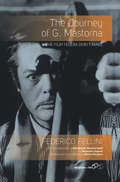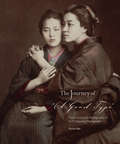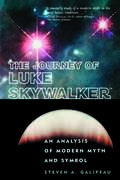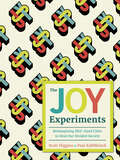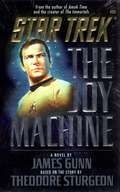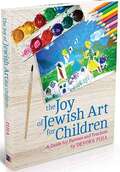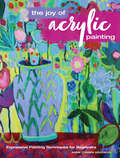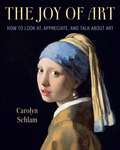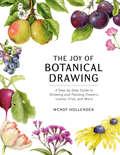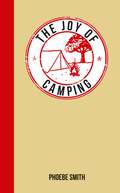- Table View
- List View
The Jeopardy! Book of Answers: 35th Anniversary
by Harry Friedman Barry GarronA celebration of thirty-five years of Alex Trebek's show, featuring the Jeopardy! All-Star Games, reminiscences, anecdotes, and lots of answers and questions. In honor of the thirty-fifth anniversary of America&’s Favorite Quiz Show®, Jeopardy!&’s producers have selected fifteen historic games from over seven thousand episodes that illustrate why the show is every bit as timely—and lively—as it was the moment Alex Trebek first took the stage in 1984. You&’ll meet Ken Jennings in his first win, and you&’ll be there for the stunning end of his record-breaking run. Experience again the epic battle of Man vs. Machine with IBM&’s Watson computer. Follow the Celebrity Invitational Finals with $1,000,000 on the line for charity. Get the play-by-play for championship showdowns, memorable tournaments, and so much more. Each game includes the complete text of the Jeopardy!, Double Jeopardy!, and Final Jeopardy! rounds along with exclusive behind-the-scenes details and photos. Get to know the contestants, and discover previously untold stories from the staff behind some of the most popular players, games, and competitions. Who knows? It may even inspire you to become the next Jeopardy! champion!
The Jermyn Street Shirt
by Jonathan SothcottJermyn Street in St James’s, London, has been the Mecca of fine British shirtmaking for more than a century. Patrons have included Cary Grant, Frank Sinatra, Roger Moore, the Beatles, Warren Beatty, Pierce Brosnan, the Prince of Wales, Sir Michael Caine and Ronald Reagan. Between them, these shirtmaking artisans have styled that most debonair of onscreen heroes, James Bond. Indeed, the Jermyn Street shirt is the ultimate in entry-level luxury menswear. For many years seen as a stuffy and elitist institution, the advent of Instagram has seen the doors to the world’s finest shirtmakers blown open as tailoring enthusiasts come together to share their passion.The Jermyn Street Shirt includes a wealth of sartorial showbusiness anecdotes as well as style tips from some of the big screen’s most dapper stars. With unique access to many of the makers, including Turnbull & Asser, Hilditch & Key and Budd, Jonathan Sothcott presents an expertly curated pictorial treasure trove of previously unseen ephemera, including celebrity shirt patterns and samples.
The Jesus Lizard Book
by The Jesus LizardLegendary indie rockers the Jesus Lizard’s idiosyncratic, impassioned document of their rock and roll conquests. “If you’re a Jesus Lizard fan or a David Yow devotee, you’re sure all over this. But even if you’ve never heard of the band, the book stands as one of the best ways to experience being in a tight, cohesive band. You get everything except the sweat, spilled beer, and blood. It’s a fun ride, and the closest thing possible to getting in the van with these guys.” —Mother Jones “The Jesus Lizard Book is a beautiful document of a band that wasn’t afraid to be abrasive, chaotic, brutal, and sometimes, ugly.” —The Chicago Tribune/Printer’s Row The Jesus Lizard Book is a coffee table affair of exclusive photography, art, and other imagery with written pieces by all four members of the seminal indie rock band the Jesus Lizard. The layout is stylish and elegant, particularly in contrast with the harshness of much of the band’s music. Included are many Polaroids by David Wm. Sims, a delicious recipe by David Yow, a concise list of every show the Jesus Lizard played, and writings by two producers who recorded the band—Steve Albini and Andy Gill. There is biographical material of each member that covers childhood to the demise of the group. Other contributors include Mike Watt, Alexander Hacke, Steve Gullick, Rebecca Gates, Jeff Lane, Sasha Frere-Jones, KRK, Bernie Bahrmasel, and many more. The Jesus Lizard (1988–1999) hailed from Chicago by way of Austin, Texas. They released seven records on the independent record label Touch and Go, and a few more on different major labels. Many have called them the best live band of the 1990s. Unlike most of their contemporaries, the Jesus Lizard managed to create a beast, an entirely autonomous being, an entity who outgrew and is very likely to also outlive its makers. While each and every personality in the group is an integral part of its mentality and thus ultimately irreplaceable, it is the rapport and friction between them which makes the music possible, allows it to blossom and eventually break free. It was not just David Wm. Sims’s monolithic basslines, but the stance he took in order to deliver them. Like a sailor manning a raft through a storm at high sea, he took position at stage left and pounded away at his instrument—stoic, reliable, and unwavering. Mac McNeilly’s drumming didn’t merrily serve as a time-giver, but as a display of unrestrained energy and a joyously bouncing, good-natured spirit. Somersaulting patterns and probability-defying breaks were stacked on top of one another, made to tumble and fall only to be caught again, as if a boxer was juggling dishes while pummeling an already delirious opponent. Duane Denison shaped his guitar work like a taxidermist dissecting a puppy. With cruel precision, he stabbed and sliced and inserted the limbs of chord progressions with bolts and rods and wire, smiling dreamily while his riffs danced around onstage like biomechanical freaks of nature. Then there was the man who is the embodiment of the band’s name, the tormented soul thrown about and struggling to withstand the torrent in the tornado of the music: David Yow spilled his insides while he spent most of the shows in—no, on—the audience, being lifted and carried by the masses that were groping and ripping at him, trying to be a part, greedily looking to get a piece of the action. He was the ingenious saboteur, the anarchistic oddball in this form of modern theater with the other three serving as the perfect “straight men” to his madness.
The Jesus Music: A Visual Story of Redemption as Told by Those Who Lived It
by Marshall TerrillA written and visual complement to the documentary film of the same name, The Jesus Music brings the history of a movement to life. Featuring Contemporary Christian Music artists across five decades, readers will experience the story that has united and changed the lives of people around the world. The Jesus Music: A Visual Story of Redemption as Told by Those Who Lived It shares that story: people creating something they wanted, something that never existed before. Written by music and film historian Marshall Terrill, the book accompanies a documentary film by award-winning directors Jon and Andy Erwin; this written and visual narrative of the genre features historic concerts and candid behind-the-scenes photographs throughout. The Jesus Music explores the history, evolution, and redemptive thread of Contemporary Christian music over the last fifty years as it spans the convergence of rock and roll, country, and gospel music. As CCM grows, readers will see California artists as much a part of hippie culture as Christian culture, religious-focused bands and songs denounced by some church leaders of the day, and best-selling artists who rose, and sometimes fell from fame, as they journey through the music and experience the often delicate balances between faith, fame, mission, and humanity as they relate to Christian music. The notable voices of Amy Grant, Michael W. Smith, Kirk Franklin, and TobyMac, as well as the stories of dozens of additional Christian artists, will hit all the right notes and explore: - The roots of the movement, spanning from Elvis Presley and Johnny Cash to Switchfoot, Chris Tomlin, Hillsong United, and beyond. - The stories of pioneers in the genre, including Larry Norman, Lovesong, and Stryper - Insights into how history, culture, and technology shaped the Contemporary Christian music we hear on the radio today. - Examples of God&’s steadfast love as He uses artists despite their human mistakes and shortcomings. - How the message of the music transforms lives and has impact beyond artistic expression. The Jesus Music is perfect for anyone looking to explore the history of the genre and discover how God can use us despite our flaws to impact the world.
The Jesus Storybook Bible Advent Activity Book: 24 Guided Crafts, plus Games, Songs, Recipes, and More (Jesus Storybook Bible)
by Sally Lloyd-JonesThis is your guide to a complete and creative celebration of the holiday season, filled with crafts, games, recipes, songs, and activities for every day of Advent. The Jesus Storybook Bible Advent Activity Book highlights the significance of the Nativity and meaning of God&’s most precious gift.The Jesus Storybook Bible Advent Activity Book is a journey through the Bible stories in both the Old and New Testaments that lead to Christmas. It includes:24 days of crafts along with songs, recipes, and activities to celebrate Advent, with easy-to-follow step-by-step instructions and color photosVariations on the activities to make them appropriate and accessible for all ages and familiesA perforated insert with punch-out Jesse Tree ornaments that correspond with the stories of AdventA heartfelt letter and reflection from New York Times bestselling author Sally Lloyd-JonesAll supplies needed are commonly found around the house or easy to obtain. This Christmas, start new holiday traditions with your family with The Jesus Storybook Bible Advent Activity Book, based on the bestselling The Jesus Storybook Bible, with over 6 million copies sold. Other titles by Sally Lloyd-Jones include: The Jesus Storybook Bible, The Jesus Storybook Bible Christmas Collection, and Song of the Stars.
The Jeweler's Studio Handbook: Traditional and Contemporary Techniques for Working with Metal and Mixed Media Materials
by Brandon HolschuhMaster the art and craft of metal jewelry making with essential techniques; extensive photos, and twenty distinctive designs.Great jewelry is original and well-designed, and—with the right tools—it can be created at home by the aspiring artist. The Jeweler’s Studio Handbook guides you through the process of equipping your own jewelry studio and teaches you the techniques that will have you crafting one-of-a-kind metal jewelry in no time.Artist Brandon Holschuh walks you through planning your work space, selecting tools and materials, mastering basic metalwork techniques, and applying your new skills to twenty original pieces. In addition, The Jeweler’s Studio Handbook encourages novel design, good organization, and fearless experimentation, ensuring it will remain an invaluable resource for jewelry artists for years to come.Invites you into the world of the home jewelry artist, from workbench to galleryTeaches fundamental jewelry-making techniques—hammering, soldering, riveting, and more—in full-color photographsIllustrates the steps for crafting twenty beautiful pieces of metalwork jewelry, including rings, bracelets, earrings, and pendantsFeatures gallery-quality jewelry from dozens of artists
The Jewelry Architect: Techniques and Projects for Mixed-Media Jewelry
by Kate MckinnonInnovative jewelry artist Kate McKinnon takes you on a creative journey of techniques and projects in The Jewelry Architect, using a variety of materials and tools to create gallery-quality bracelets, necklaces, and rings.Beautiful photographs and clearly written instructions give jewelry artists the building blocks to combine wire, metal clay, beadwork, and traditional metalsmithing to create one-of-a-kind wearable art pieces. Learn how to merge techniques to form 16 uniquely designed projects, and also how to manufacture a variety of components such as clasps, hooks, earring findings, and ring bases to customize your work. Revel in Kate's signature style - an earthy ménage of metal, beads, and fibers - as she shares tips on the best ways to reinforce beadwork, bind edges, string components, form metal clay ring bands, fuse rings, create head pins, and so much more.
The Jewelry Engravers Manual
by John J. Bowman R. Allen HardyMany engraving books on the market illustrate the forms and appearance of finished designs but fail to provide adequate instructions for actual engraving. In sharp contrast, this comprehensive and practical manual by two educators and master craftsmen teaches every step of the engraving process. Clear, step-by-step instructions, accompanied by scores of illustrations, tell how to cut initials and inscriptions using a variety of alphabets, including script, ribbon, vertical script, and Roman letters as well as block and Old English. You'll also learn how to design and cut initials in monograms, what forms to use for properly decorating and embellishing engraved work, and how to correctly shape and maintain tools, particularly square script gravers -- a tool basic to many different kinds of engraving. A glossary of terms and extensive, helpful question-and-answer section round out this immensely beneficial guide.While practicing artisans will find many useful suggestions for improving their professional work, beginners will especially consider The Jewelry Engravers Manual a valuable tool for mastering the art of engraving.
The Jewelry Maker's Field Guide: Tools and Essential Techniques
by Helen DriggsDiscover a thorough reference guide to metalworking tools and techniques with multiple demos, tutorials, cross-references, and supportive skill-building exercises and projects. Helen I. Driggs, senior editor for Lapidary Journal Jewelry Artist , brings her down-to-earth approach and strong metalworking knowledge base to this overview of basic and not-so-basic metalworking techniques. The Jewelry Maker's Field Guide walks you through the variety of metalworking tools available and offers guidance on setting up a studio, buying and organizing supplies, and determining what tools to buy and when. Organizing tools by basic functions, Helen offers a solid and logical overview of metalworking techniques and teaches sets of related skills, showing how different tools can sometimes achieve the same end. Each chapter includes stepped demos and applied techniques for using particular tools. The book culminates in projects that combine a variety of techniques and allow the reader to further apply and practice their metalworking skills. Get a solid foundation for understanding the basic (and not so basic) processes of metalwork!
The Jewelry Repair Manual
by R. Allen HardyWritten for the jeweler who wishes to expand his jewelry repair department, this profusely illustrated manual will help both novices and experienced crafters. It provides clear, step-by-step instructions for cleaning and repairing jewelry and setting stones, as well as complete descriptions of the tools and equipment needed, and their proper use and care.Newcomers to the trade will find detailed explanations of such basic procedures as filing, soldering, buffing, and mounting presented in full detail. Readers will also find easy-to-follow discussions of developments in ultrasonics, steaming, electroplating, and other important techniques.With this simply written guide, jewelers will be able to perform a wide range of repair jobs on premises, enabling them to offer customers faster, better service. This will not only increase repair volume but will help sales as well. For this updated edition, Mr. Hardy has added an extensive appendix reprinting questions and his answers to them from American Horologist and Jeweler, of which he was technical editor for sixteen years, along with discussions of various salient topics.
The Jewish Decadence: Jews and the Aesthetics of Modernity
by Jonathan FreedmanAs Jewish writers, artists, and intellectuals made their way into Western European and Anglo-American cultural centers, they encountered a society obsessed with decadence. An avant-garde movement characterized by self-consciously artificial art and literature, philosophic pessimism, and an interest in nonnormative sexualities, decadence was also a smear, whereby Jews were viewed as the source of social and cultural decline. In The Jewish Decadence, Jonathan Freedman argues that Jewish engagement with decadence played a major role in the emergence of modernism and the making of Jewish culture from the 1870s to the present. The first to tell this sweeping story, Freedman demonstrates the centrality of decadence to the aesthetics of modernity and its inextricability from Jewishness. Freedman recounts a series of diverse and surprising episodes that he insists do not belong solely to the past, but instead reveal that the identification of Jewishness with decadence persists today.
The Jonas Brothers: Issue #4 (Scoop! The Unauthorized Biography #4)
by Jennifer PouxIntroducing a new series of unauthorized biographies on the world's biggest names and rising stars in entertainment, sports, and pop culture! Complete with quizzes, listicles, trivia, and a full-color pull-out poster of the star, this is the definitive collection to get the full Scoop! and more on your favorite celebrities.Nick, Joe, and Kevin. Can you name a more iconic trio? From their early singing days with their mop-top haircuts, to their meteoric rise to superstar status, and then an abrupt breakup in 2013, the Jonas bros are back...and this time they're clean-cut and wifed up. But what's next for the Jonas bros and J sisters? Get the full Scoop! and more on pop's most iconic trio.
The Jottery
by Andy SelsbergIn The Jottery, you'll find a series of prompts, suggestions, commands, and questions that are intended to cause neurons to fire and a spectrum of ideas to surface--possibly good, potentially useful, conceivably profitable, maybe illuminating, and hopefully amusing. There's also a chance you'll come up with nothing, and experience a beautiful "idea-lessness" that would be the envy of Zen monks everywhere. Also a win.Think of this as The Book of Questions for creative types, from writers and artists, to idea gurus and daydreamers, perfect for writing classes, train rides, parties, meditation retreats, game nights, insomnia bouts, lulls in dates or low points in relationships, company brainstorming meetings, waiting rooms, therapy sessions, and more. The dozens of ingenious prompts include:You create something called Soul Lotion. What are the best places to rub it? (Don't limit your answer to human body parts.)You're commissioned to design a bridge to nowhere. Briefly describe possible nowheres you might build it to.Where did the fun go? Suggest four hyper-specific places. If you do manage to track the fun down and tie it to a chair, what do you do or do with it?You're commissioned to write a pilot script for a post-apocalyptic sitcom. It's based not on the next post-apocalyptic period, but the one after that, after a new civilization arises and collapses. What are seven things you do to celebrate this cool new job?You design vending machines that sell things that are not physical objects. Like what? And for how much?List twelve things you can have instead of "it all."List a handful of elevator tension-breakers, and a handful of elevator tension-makers.
The Journal Junkies Workshop: Visual Ammunition for the Art Addict
by Eric M. Scott David R. ModlerYOUR MISSION: Discover the tactical secret of self expression--the art journal! Harness the artistic explosion ticking in your head, just looking for a creative way to detonate. Prepare to be bombarded with ideas, techniques and suggestions as you allow your creativity to take hold. The Journal Fodder Junkies are on a mission, ready to arm you with all that you need to explore artistic ways of recording your life and thoughts. Part sketchbook, part diary, part notebook, part dream journal, part daily planner, part to-do list and part doodle pad, the art journal is different things to different people. Whatever it is for you, the Journal Junkies Workshop contains all the covert inspiration and know-how you'll need to get started. Uncover your own path, your own voice, your own style. Inside you'll find: Basic information on the supplies and materials you'll need to start your journal experience. Step-by-step presentation of techniques using water colors, acrylic paint, image transfers and more. Chapter-by-chapter demonstration that follows the Junkies' techniques as they layer a page, taking it from blank canvas to dynamic document. Ideas on how to get started writing in your journal, covering both what to write and inventive ways of writing it. Gallery spreads taken straight from the authors' journals that give you a unique opportunity to peer inside the heads of two experienced art journalists. Grab a journal and begin basic training today with Eric Scott and David Modler to become a Journal Fodder Junkie!
The Journal of the Right Hon. Sir Joseph Banks During Captain Cook's First Voyage in Endeavour in 1768-71: to Terra del Fuego, Otahite, New Zealand, Australia, the Dutch East Indies, Etc.
by Joseph BanksSir Joseph Banks (1743–1820) was a British botanist and one of the most influential scientific patrons of the eighteenth century. After inheriting a fortune on the death of his father in 1761, Banks devoted his life to studying natural history. His fame following his participation in Captain Cook's epic voyage on the Endeavour between 1768 and 1771 led to his election as President of the Royal Society in 1778, a post which he then held until his death. This volume, first published in 1896, contains Banks' account of the voyage of the Endeavour across the Pacific Ocean. Edited by the great botanist Sir Joseph Hooker, it describes in fascinating detail the peoples, cultures and wildlife Banks encountered in Tahiti, New Zealand and Australia. Banks' aptitude as a natural historian and the crucial role he played in cataloguing and illustrating exotic wildlife during the expedition are emphasised in the work.-Print ed.
The Journey Of G. Mastorna
by Federico FelliniFederico Fellini's script for perhaps the most famous unmade film in Italian cinema, The Journey of G. Mastorna (1965/6), is published here for the first time in full English translation. It offers the reader a remarkable insight into Fellini's creative process and his fascination with human mortality and the great mystery of death. Written in collaboration with Dino Buzzati, Brunello Rondi, and Bernardino Zapponi, the project was ultimately abandoned for a number of reasons, including Fellini's near death, although it continued to inhabit his creative imagination and the landscape of his films for the rest of his career. Marcus Perryman has written two supporting essays which discuss the reasons why the film was never made, compare it to the two other films in the trilogy La Dolce Vita and 8½, and analyze the script in the light of It's a Wonderful Life and Fredric Brown's sci-fi novel What Mad Universe. In doing so he opens up an entire world of connections to Fellini's other films, writers and collaborators. It should be essential reading for students and academics studying Fellini's work.
The Journey of "A Good Type": From Artistry to Ethnography in Early Japanese Photographs
by David OdoWhen Japan opened its doors to the West in the 1860s, delicately hand-tinted photographic prints of Japanese people and landscapes were among its earliest and most popular exports. David Odo studies the collection of Japanese photographs at Harvard’s Peabody Museum and the ways they were produced, acquired, and circulated in the nineteenth century.
The Journey of Luke Skywalker
by Steven A. GalipeauUsing C. G. Jung's approach to dreams and myths, Jungian analyst Steven Galipeau reveals to readers the wealth of symbolism and meaning embedded in George Lucas's modern fairytale. From the battle between light femininity and dark masculinity to the conflict between nature and technology, Galipeau explains why the characters and themes in the movies resonate so deeply with us. Appealing to Star Wars fans as well as those interested in popular culture, contemporary myths, and archetypes, The Journey of Luke Skywalker will bring new insight to the most popular film series of the last two decades."Behind the space dogfights and light-saber duels is a mythology that touches a chord in the human psyche . . . this title will be the basis of many internet discussions-not to mention term papers-by fans who will enjoy it. Recommended."-Michael Rogers, Library Journal
The Joy Experiments: Reimagining Mid-sized Cities to Heal Our Divided Society
by Scott Higgins Paul KalbfleischA new perspective on developing shared joy in urban spaces.Our divided society is quickly reaching crisis level. We are no longer able to sustain social and economic prosperity nor ensure democracy. Fuelling this crisis is a growing sense of social isolation caused by the divisive nature of social media and the decline of infrastructure that used to bring communities together.But there is hope for rebuilding our collaborative society, and it is found in our mid-sized urban areas. These towns and cities offer a scale that can tangibly change the quality of our lives and an intimacy that allows us to influence what our communities can become. Changing cities can change the world!In The Joy Experiments, real estate developer Scott Higgins and creative mind Paul Kalbfleisch use their own mid-sized city-building experiences to present a new way for citizens to engage with their city, and an urban planning strategy that prioritizes infrastructure for the human spirit.
The Joy Machine (Star Trek #80)
by James Gunn Theodore SturgeonTimshel was once the vacation spot of the galaxy, full of culture, natural beauty, and friendly, hospitable inhabitants. But now Timshel has cut itself off from the universe. No one is allowed to enter or leave. Concerned, the Federation has sent agents to investigate, but none have returned. Captain Kirk and the crew of the Starship Enterprise TM are shocked to discover the truth: the people of Timshel have succumbed to an insidious new technology that guarantees every citizen total pleasure, a soul-destroying ecstasy that has enslaved their entire civilization. Kirk and Spock have faced many threats before, but now they face the most seductive menace of all: perfect happiness. And the rest of the Federation may soon fall under the irresistible control of the Joy Machine.
The Joy Of Jewish Art For Children
by Devorah PihaDevora Piha is the art teacher you always dreamed of for your children. She is creative, nurturing, and makes Judaism come alive in ways many of us have never imagined. In this incredible work, Mrs. Piha has gathered over thirty years of her knowledge, experience, and excitement to share with Jewish parents and teachers. She provides dozens of ready-to-go projects as well as countless lessons, ideas, and stories to bring Jewish art into our lives-and hearts.
The Joy of Acrylic Painting: Expressive Painting Techniques for Beginners
by Annie GonzalesNow is the time to pursue creative fulfillment! Annie O'Brien Gonzales felt a passion for art from an early age. But not until 30 years later--after raising a family and working "a real job"--did she get serious about painting. Along the way, she experienced the pleasures and the pitfalls of learning to paint. In these pages, she channels it all to help others discover (or re-discover) The Joy of Acrylic Painting. This guide offers an engaging, streamlined approach for any beginner, but especially those who--due to life detours or lack of time--had previously postponed their artistic aspirations. In a fun, instantly gratifying style, Gonzales combines the forgiveness of acrylics with the approachability of expressive painting. With special emphasis on the elements of color, pattern and texture, these lessons give you a jump-start on painting with feeling. If now is your time to pursue creative fulfillment, then this is the book to ease your way.Strategies for gathering resonant ideas and inspirationPractical advice, such as when to splurge and where to save on painting suppliesMixed-media techniques for creating character in your paintingsInspiration from Expressionist masters, including ways to use their work as a jumping-off point for your own original paintingsPLUS 8 fabulous start-to-finish painting projects--landscapes, still life, figures and abstracts
The Joy of Art: How to Look At, Appreciate, and Talk about Art
by Carolyn SchlamAn Artist&’s Insights on Art Appreciation Written by a practicing artist, this book decodes and maps the basic elements of visual art, leading the reader to a greater understanding and appreciation. Not an art history lesson per se, this illustrated guide is rather a tool kit to make the study of art and a visit to the museum truly rewarding. An entertaining and informative read, The Joy of Art offers the reader:A working art vocabulary to help you identify and explain what you&’re looking atAnswers to many of the questions you may have about visual art in generalA summary of the basic criteria to consider when looking at artHighlights of the primary art genres and an introduction to the artists who pursued themMany visual examples of aesthetic considerations and practicesInteresting facts about your favorite artists and clues to why they made the choices they didA few games to test your new skillsThe Joy of Art contains 150 color photographs and many interesting insights from an artist-author who takes readers behind the curtain and into the studio to uncover what actually goes into making a work of art. If you love art, this book will take your appreciation to a new level. Not only will your enjoyment of art increase, you&’ll be able to clearly communicate your understanding to others.
The Joy of Botanical Drawing: A Step-by-Step Guide to Drawing and Painting Flowers, Leaves, Fruit, and More
by Wendy HollenderA gorgeous, easy-to-follow, and inspiring guide to stunningly realistic botanical drawing that covers everything you need to draw our natural world.Achieve amazingly realistic and vibrant botanical illustrations, from flowers so dazzling you feel as if you might be able to smell them, to tomatoes that look as if they've just been picked from the garden. Wendy Hollender is known for her vivid, detailed, and inspiring illustrations and in The Joy of Botanical Drawing, she helps you take your art to the next level by sharing her perfected techniques through short lessons that start simple, then build on the basics with easy-to-use and clear step-by-step illustrations. Using colored pencils and watercolor pencils, Hollender shows you how to accomplish scientifically accurate botanical portraits of a spiraling pine cone, a spiky chestnut, a fuchsia-tined radish, a graceful morning glory, and many more.From colorful leaves to delicate petals to textured bark and slender stems, The Joy of Botanical Drawing will give you the skills to complete lifelike drawings while also enjoying nature and the mindfulness of a regular drawing practice.
The Joy of Camping: For Those Who Love the Great Outdoors (The\joy Of Ser.)
by Phoebe SmithThis pocket-sized miscellany, packed with tips on equipment, food, surviving bad weather and finding the right campsite, and with facts and stories from the world of camping, is perfect for anyone who knows the incomparable joy and adventure of pitching their tent under an open sky.
